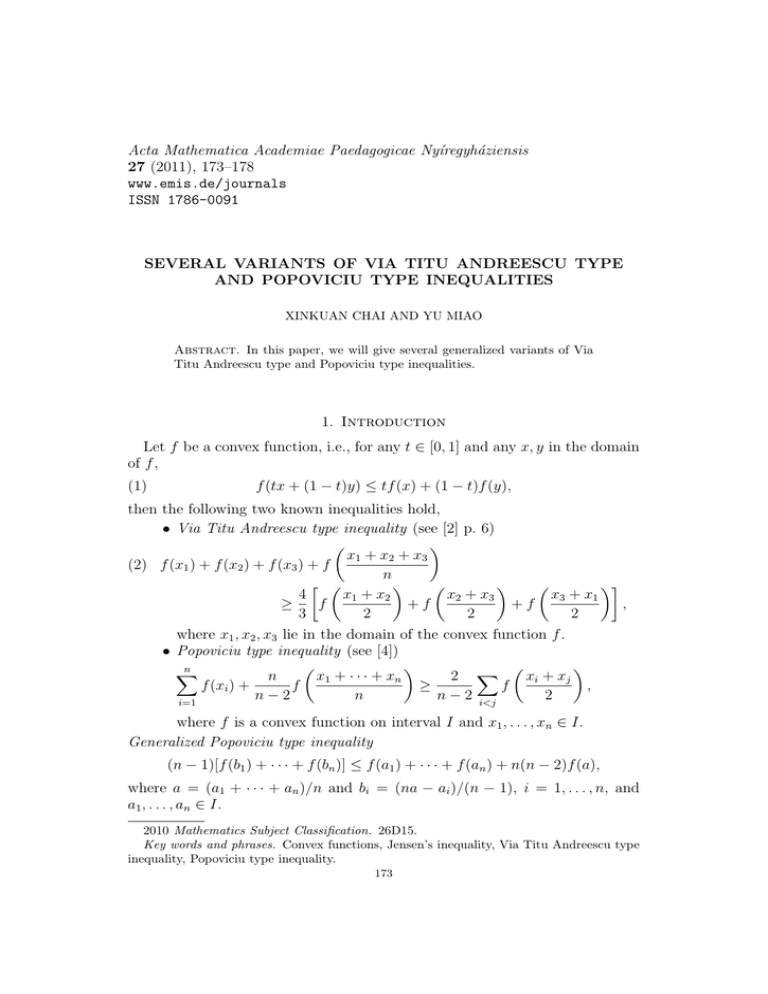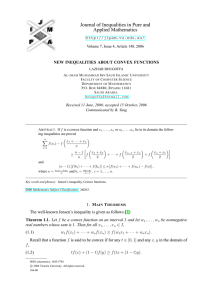Acta Mathematica Academiae Paedagogicae Ny´ıregyh´ aziensis 27
advertisement

Acta Mathematica Academiae Paedagogicae Nyı́regyháziensis
27 (2011), 173–178
www.emis.de/journals
ISSN 1786-0091
SEVERAL VARIANTS OF VIA TITU ANDREESCU TYPE
AND POPOVICIU TYPE INEQUALITIES
XINKUAN CHAI AND YU MIAO
Abstract. In this paper, we will give several generalized variants of Via
Titu Andreescu type and Popoviciu type inequalities.
1. Introduction
Let f be a convex function, i.e., for any t ∈ [0, 1] and any x, y in the domain
of f ,
(1)
f (tx + (1 − t)y) ≤ tf (x) + (1 − t)f (y),
then the following two known inequalities hold,
• Via Titu Andreescu type inequality (see [2] p. 6)
x1 + x2 + x3
(2) f (x1 ) + f (x2 ) + f (x3 ) + f
n
x1 + x2
x2 + x3
x 3 + x1
4
≥
f
+f
+f
,
3
2
2
2
where x1 , x2 , x3 lie in the domain of the convex function f .
• Popoviciu type inequality (see [4])
n
X
x 1 + · · · + xn
2 X
xi + xj
n
f
≥
f
,
f (xi ) +
n−2
n
n − 2 i<j
2
i=1
where f is a convex function on interval I and x1 , . . . , xn ∈ I.
Generalized Popoviciu type inequality
(n − 1)[f (b1 ) + · · · + f (bn )] ≤ f (a1 ) + · · · + f (an ) + n(n − 2)f (a),
where a = (a1 + · · · + an )/n and bi = (na − ai )/(n − 1), i = 1, . . . , n, and
a1 , . . . , an ∈ I.
2010 Mathematics Subject Classification. 26D15.
Key words and phrases. Convex functions, Jensen’s inequality, Via Titu Andreescu type
inequality, Popoviciu type inequality.
173
174
XINKUAN CHAI AND YU MIAO
Recently, Bougoffa [1] obtained the following variant of Via Titu Andreescu
type and Popoviciu type inequalities.
Theorem B. If f is a convex function and x1 , . . . , xn or a1 , . . . , an lie in its
domain, then the following inequalities hold,
n
X
x1 + · · · + xn
f (xi ) − f
(3)
≥
n
i=1
n−1
x1 + x2
xn−1 + xn
x n + x1
f
+ ··· + f
+f
n
2
2
2
and
(4)
(n − 1)[f (b1 ) + · · · + f (bn )] ≤ n[f (a1 ) + · · · + f (an ) − f (a)],
where a = (a1 + · · · + an )/n and bi = (na − ai )/(n − 1), i = 1, . . . , n.
The aim of the present paper is to show the more generalized inequalities in
Theorem B, which are stated and proved in Section 2.
2. Main results
Before showing our main results, we need recall the well-known Jensen’s
inequality
Lemma 2.1 (see [3]). Let f be a convex function on an interval I and let
w1 , . . . , wn be nonnegative real numbers whose sum is 1. Then for all x1 , . . . , xn
∈ I,
(5)
w1 f (x1 ) + · · · + wn f (xn ) ≥ f (w1 x1 + · · · + wn xn ).
Theorem 2.1. For any n and 1 ≤ k ≤ n − 1, let f be a convex function
and x1 , . . . , xn lie in its domain and let {ci,j }1≤i≤n,1≤j≤k+1 be nonnegative real
Pk+1
numbers with
j=1 ci,j = 1 for all 1 ≤ i ≤ n. In addition, assume that
xn+1 = x1 , . . . , xn+k = xk , then we have
!
!
n
n
n
k+1
X
X
1X
n−1X
ci,l xi+l−1 ,
(6)
ai f (xi ) − f
a i xi ≥
f
n i=1
n i=1
i=1
l=1
where
(7)
(P
Pk+1
i
c
+
l,i
l=i+1 cn−k+l−1,k−l+3 ,
ai := Pl=1
k+1
l=1 ci−l+1,l
1≤i≤k
k + 1 ≤ i ≤ n.
Proof. For any 1 ≤ i ≤ n and 1 ≤ k ≤ n − 1, by the Jensen’s inequality (note
ci,1 + · · · + ci,k+1 = 1), we have
f (ci,1 xi + ci,2 xi+1 + · · · + ci,k+1 xi+k ) ≤
k+1
X
l=1
ci,l f (xi+l−1 ).
VIA TITU ANDREESCU AND POPOVICIU TYPE INEQUALITIES
Thus,
n
X
f
i=1
=
k+1
X
≤
ci,l xi+l−1
k
i
X
X
n
X
n X
k+1
X
i=1 l=1
l=1
i=1
,
!
k+1
X
cl,i +
l=1
175
ci,l f (xi+l−1 )
!
cn−k+l−1,k−l+3 f (xi ) +
l=i+1
n X
k+1
X
ci−l+1,l f (xi )
i=k+1 l=1
ai f (xi ).
i=1
P
Furthermore, noting the fact ni=1 ai = n and using the Jensen’s inequality
again,
" n
#
n
n
X
X
1X
n
ai f (xi ) −
ai f (xi )
ai f (xi ) =
n
−
1
n
i=1
i=1
i=1
" n
!#
n
X
X
n
1
≤
ai f (xi ) − f
ai xi
n − 1 i=1
n i=1
which implies our result.
Remark 2.1. If let k = 1, xn+1 = x1 and for any 1 ≤ i ≤ n, ci,1 = ci,2 = 1/2,
then ai = 1 and from Theorem 2.1, we obtain
!
!
n
n
2
n
X
n−1X
1X
1X
xi+l−1
xi ≥
f
f (xi ) − f
n i=1
n i=1
2 l=1
i=1
which is the inequality (3).
Theorem 2.2. For any n, let f be a convex function and x1 , P
. . . , xn lie in
its domain and let {ci }1≤i≤n be nonnegative real numbers with ni=1 ci = 1.
In addition, assume that for any 1 ≤ k ≤ n − 1, xn+1 = x1 , . . . , xn+k = xk ,
cn+1 = c1 , . . . , cn+k = ck , then we have
!
n
n
X
1X
(8)
ai f (xi ) − f
a i xi
n
i=1
i=1
n−1X
≥
f (ci xi + ci+1 xi+1 + · · · + (1 − ci − · · · − ci+k−1 )xi+k ),
n i=1
n
where
(9)
(
P
ici + (k − i)cn+i + 1 − kl=1 cn+i−l ,
P
ai :=
kci + 1 − kl=1 ci−l
1≤i≤k
k + 1 ≤ i ≤ n.
176
XINKUAN CHAI AND YU MIAO
Proof. As the similar proof as Theorem 2.1, for any 1 ≤ i ≤ n,
f (ci xi + ci+1 xi+1 + · · · + (1 − ci − · · · − ci+k−1 )xi+k )
≤
k
X
ci+l−1 f (xi+l−1 ) + (1 − ci − · · · − ci+k−1 )f (xi+k ).
l=1
Therefore, we have
n
X
f (ci xi + ci+1 xi+1 + · · · + (1 − ci − · · · − ci+k−1 )xi+k )
i=1
≤
n
k
X
X
i=1
=
k
X
!
ci+l−1 f (xi+l−1 ) + (1 − ci − · · · − ci+k−1 )f (xi+k )
l=1
ici + (k − i)cn+i + 1 −
i=1
+
n
X
kci + 1 −
i=k+1
Furthermore, noting the fact
k
X
!
ci−l
k
X
!
cn+i−l
f (xi )
l=1
f (xi ) ,
n
X
ai f (xi ).
i=1
l=1
Pn
ai = n and using the Jensen’s inequality,
#
n
n
n
X
X
n
1X
ai f (xi ) =
ai f (xi ) −
ai f (xi )
n − 1 i=1
n i=1
i=1
" n
!#
n
X
n
1X
≤
ai f (xi ) − f
ai xi
n − 1 i=1
n i=1
which implies our result.
i=1
"
Pn
Remark 2.2. If let k = 1, xn+1 = x1 and i=1 ci = 1, then a1 = c1 + (1 − cn ),
ai = ci + (1 − ci−1 ), 2 ≤ i ≤ n and from Theorem 2.2, we obtain
!
n
n
X
1X
(10)
(ci + (1 − ci−1 ))f (xi ) − f
(ci + (1 − ci−1 ))xi
n
i=1
i=1
n−1X
≥
f (ci xi + (1 − ci )xi+1 ),
n i=1
n
where c0 = cn .
The variant of the generalized Popovicui inequality is given in the following
theorem.
Theorem 2.3. If f is a convex function and x1 , x2P
. . . , xn lie in its domain
and let {ci }1≤i≤n be nonnegative real numbers with ni=1 ci = 1. In addition,
VIA TITU ANDREESCU AND POPOVICIU TYPE INEQUALITIES
for any 1 ≤ i ≤ n, let a =
(11)
177
Pn
and bi = (a − ci ai )/(1 − ci ), then
!#
n
n
n
X
X
1X
(n − 1)
f (bi ) ≤ n
Kj cj f (aj ) − f
Kj c j a j
,
n
i=1
j=1
j=1
i=1 ci ai
"
where for any 1 ≤ j ≤ n,
Kj =
n
X
1
Pn
j=1,j6=i cj
i=1,i6=j
.
Proof. By using the Jensen’s inequality, for any 1 ≤ i ≤ n, we have
!
n
X
1
cj
Pn
f (bi ) = f
(a − ci ai ) = f
aj
1 − ci
j=1,j6=i cj
j=1,j6=i
≤
n
X
Pn
cj
j=1,j6=i cj
j=1,j6=i
f (aj ) .
Thus by summing for i from 1 to n, we have
n
X
f (bi ) ≤
i=1
n
n
X
X
Pn
i=1 j=1,j6=i
=
,
n
X
n
X
j=1
i=1,i6=j
n
X
cj
j=1,j6=i cj
Pn
f (aj )
1
j=1,j6=i cj
!
cj f (aj )
Kj cj f (aj ).
j=1
P
Furthermore, noting the fact that nj=1 Kj cj = n and using Jensen’s inequality,
" n
#
n
n
X
X
n
1X
Kj cj f (aj ) =
Kj cj f (aj ) −
Kj cj f (aj )
n − 1 j=1
n j=1
j=1
!#
" n
n
X
1X
n
.
Kj cj f (aj ) − f
Kj cj aj
≤
n − 1 j=1
n j=1
which means our result.
Remark 2.3. For all 1 ≤ i ≤ n, let ci = 1/n, then a = (a1 + · · · + an )/n,
bi = (na − ai )/(n − 1) and Ki ci = 1, therefore we get
" n
!#
n
n
X
X
1X
(n − 1)
f (bi ) ≤ n
f (aj ) − f
aj
,
n j=1
i=1
j=1
which is the inequality (4).
178
XINKUAN CHAI AND YU MIAO
References
[1] L. Bougoffa. New inequalities about convex functions. JIPAM. J. Inequal. Pure Appl.
Math., 7(4):Article 148, 3 pp. (electronic), 2006.
[2] K. Kedlaya. A < B (A is less than B). based on notes for the Math Olympiad Program
(MOP) Version 1.0, last revised August 2, 1999.
[3] D. S. Mitrinović, J. E. Pečarić, and A. M. Fink. Classical and new inequalities in analysis,
volume 61 of Mathematics and its Applications (East European Series). Kluwer Academic
Publishers Group, Dordrecht, 1993.
[4] T. Popoviciu. Sur certaines inégalités qui caractérisent les fonctions convexes. An. Şti.
Univ. “Al. I. Cuza” Iaşi Secţ. I a Mat. (N.S.), 11B:155–164, 1965.
Received March 17, 2010.
X. K. Chai,
College of Mathematics and Information Science,
Henan Normal University,
Henan Province, 453007,
China
Y. Miao,
College of Mathematics and Information Science,
Henan Normal University,
Henan Province, 453007,
China
E-mail address: yumiao728@yahoo.com.cn







